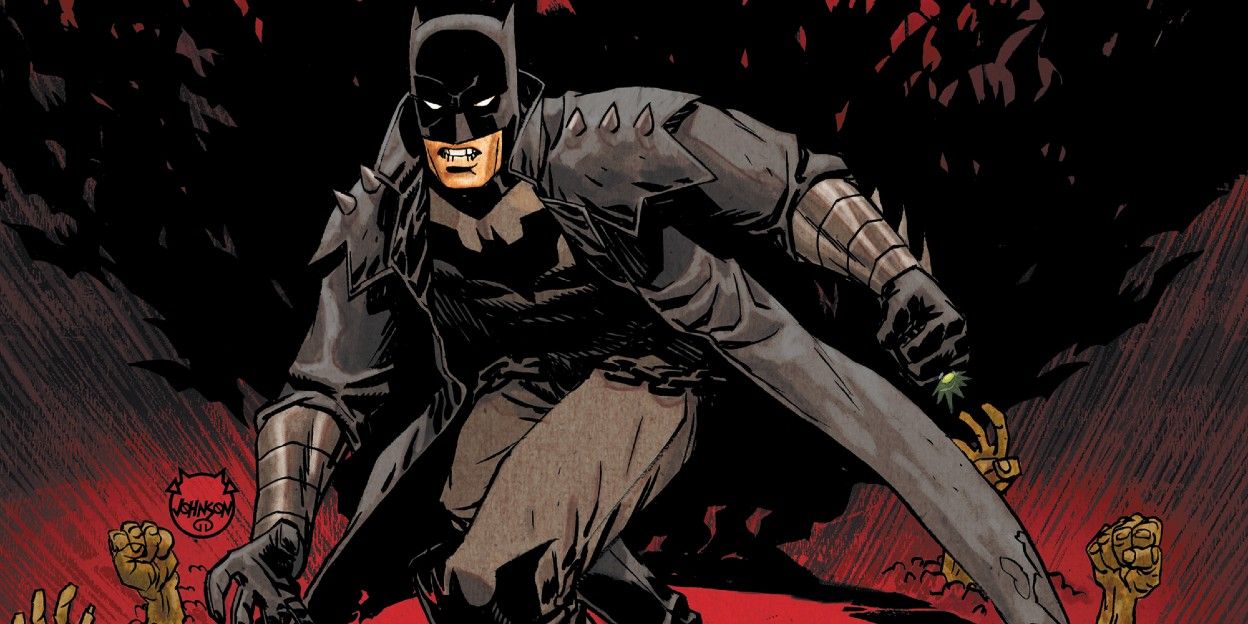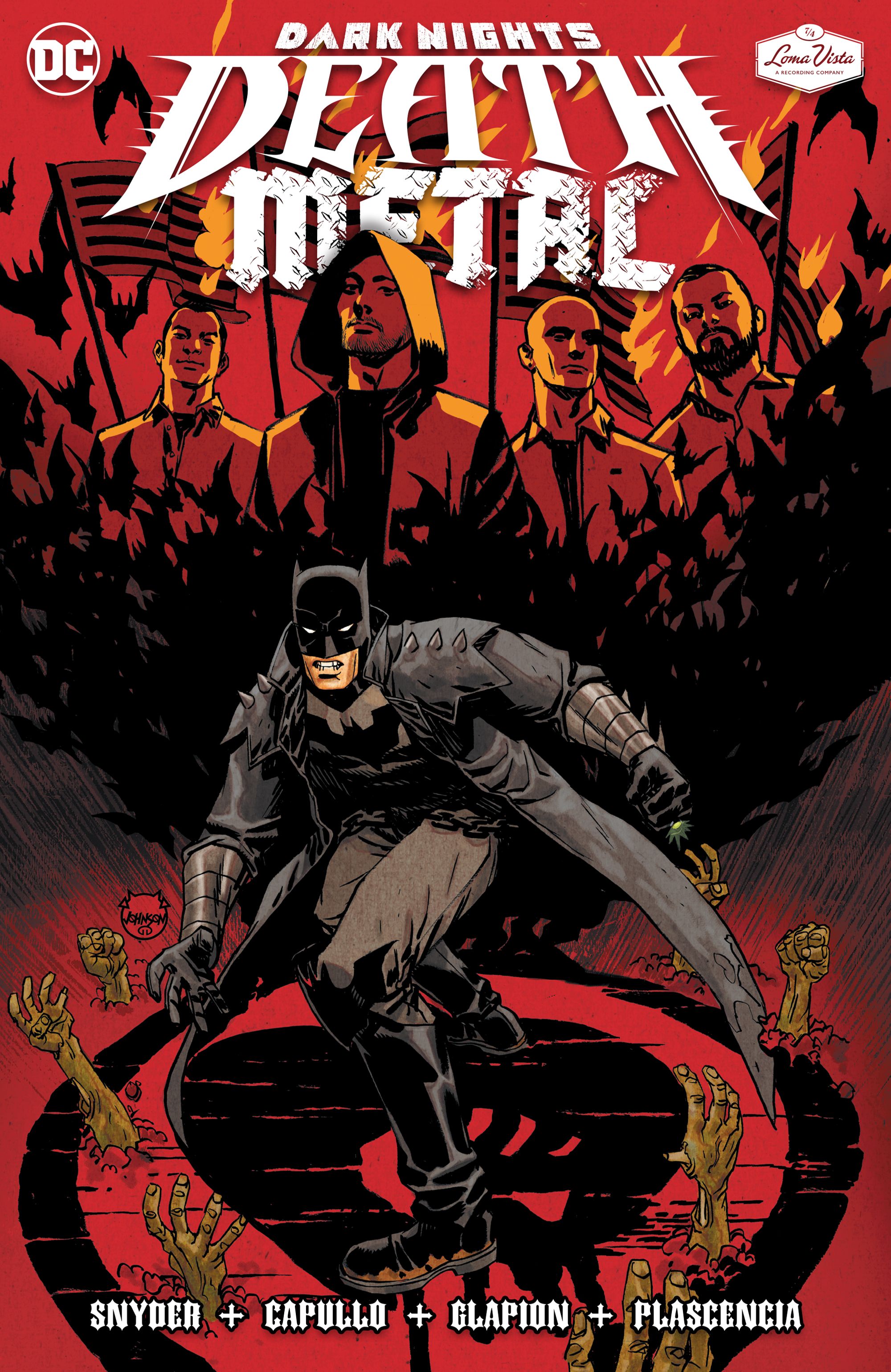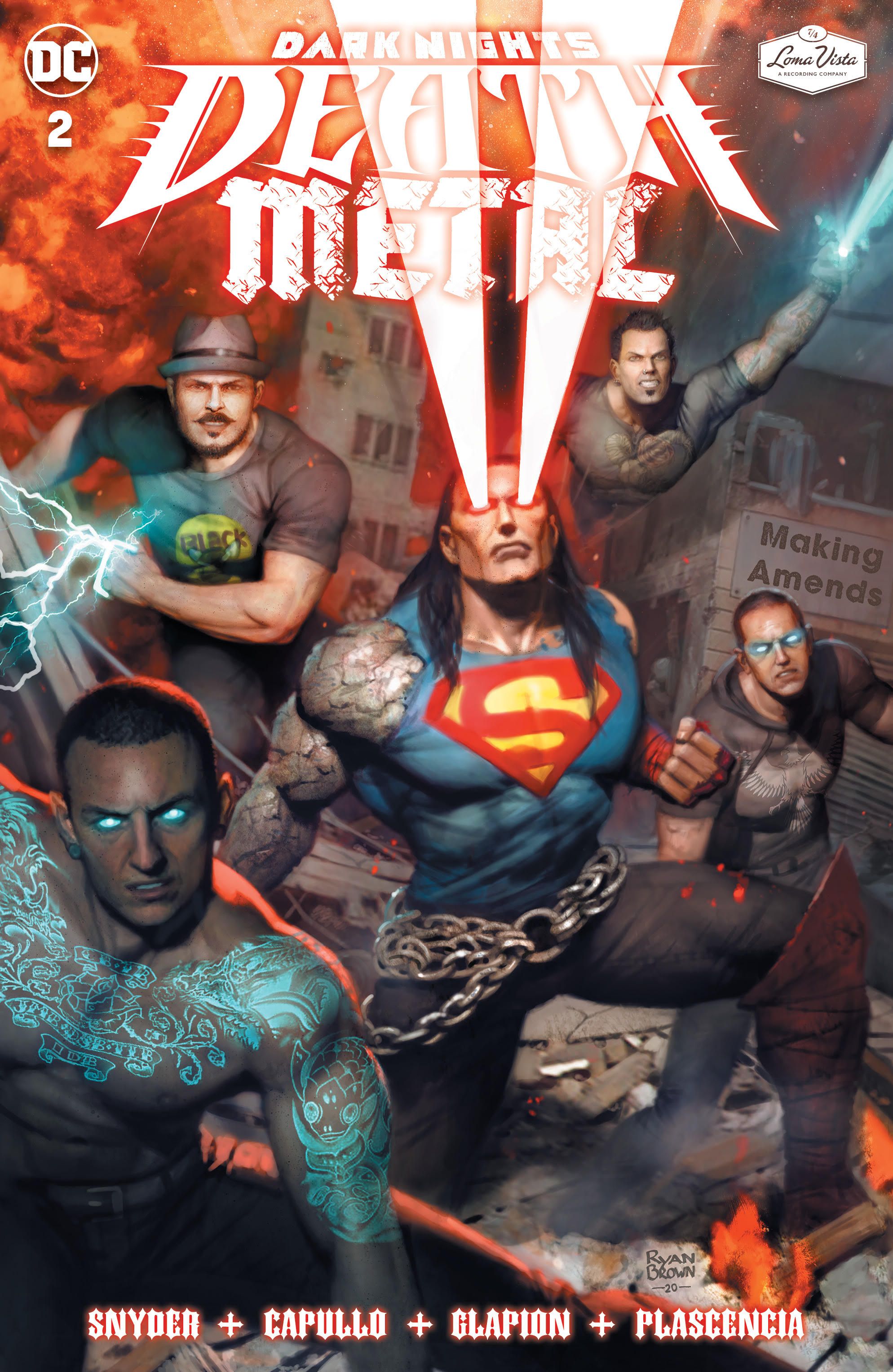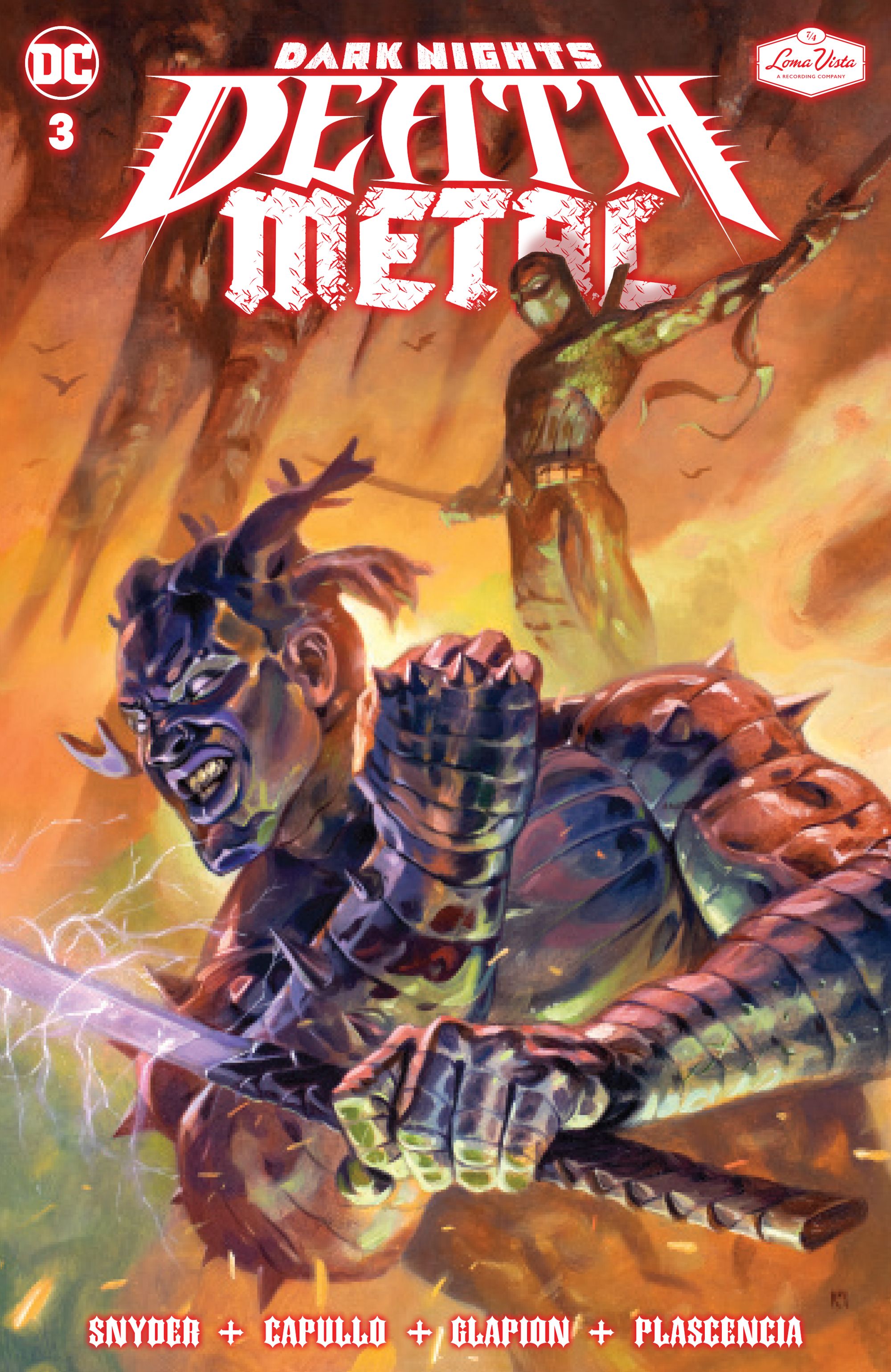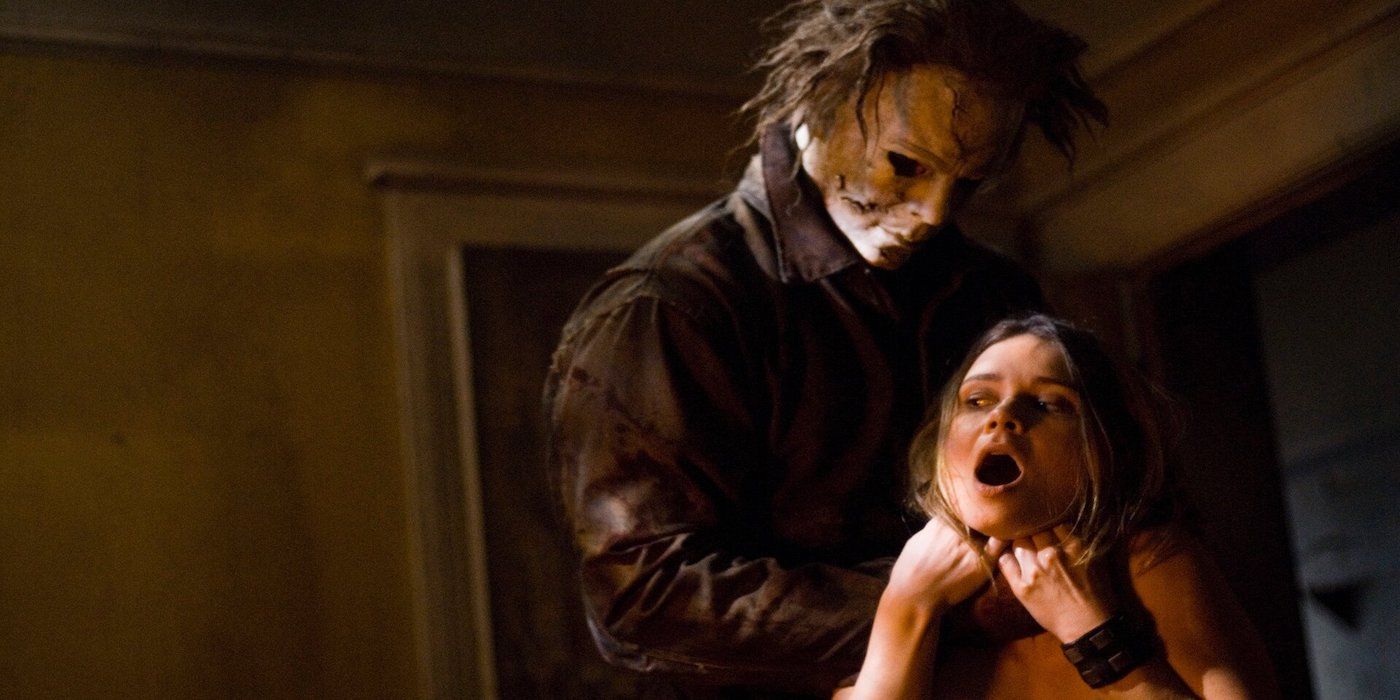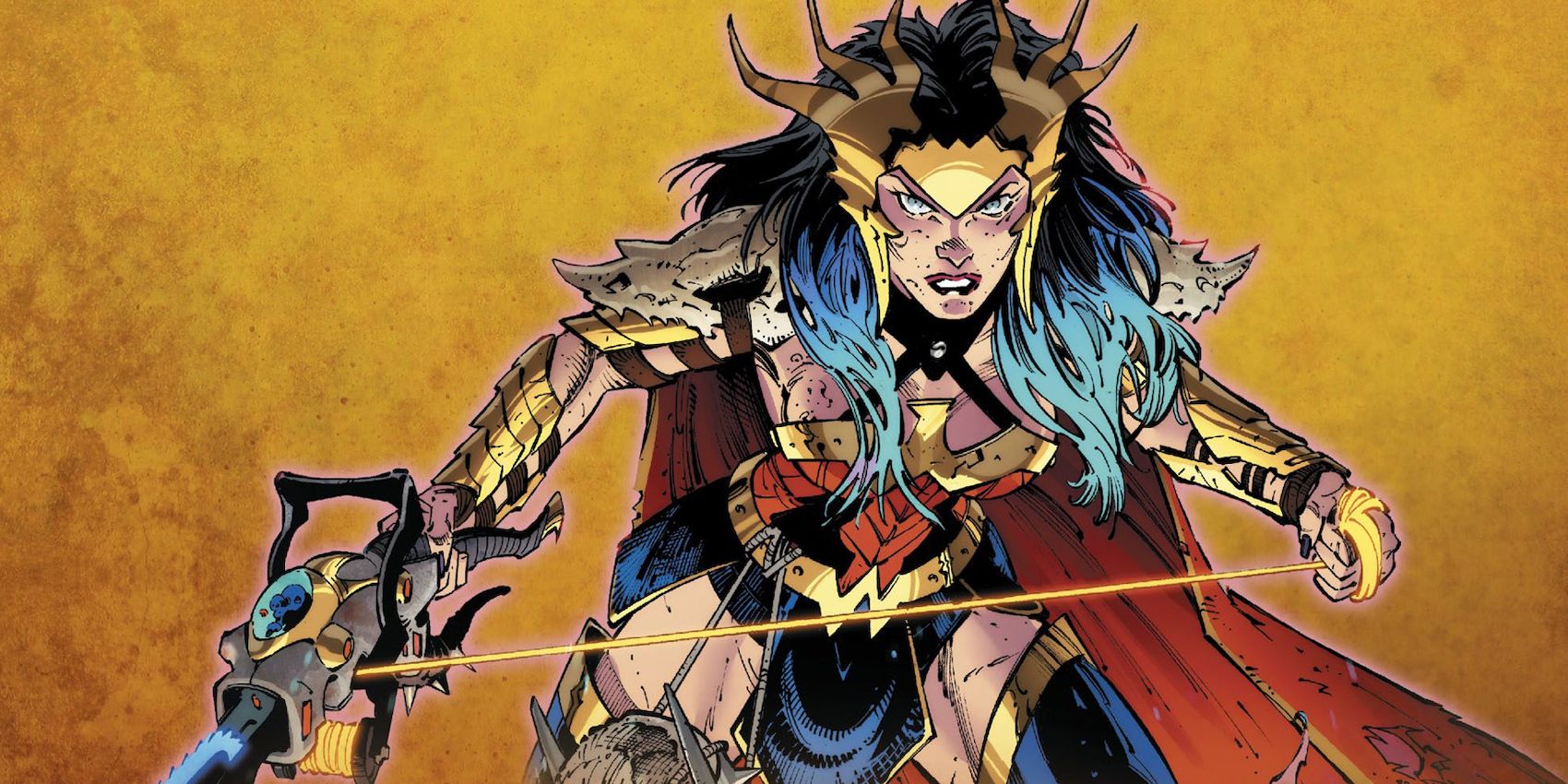One of the biggest crossover events in DC history was Dark Nights: Death Metal. Created by Scott Snyder and Greg Capullo, the wild event concluded at the beginning of the year and set the stage for the DC Multiverse's Infinite Frontier era. Inspired by its epic stakes and heavy metal premise, prolific composer and producer Tyler Bates helmed the creation of a concept album based in its world. Bates gathered an impressive lineup of musicians to forge the Sonic Metalverse in Dark Nights: Death Metal Soundtrack, featuring rock stars like Mastodon and Starcrawler on a gorgeous vinyl pressing, with a special edition available to order now.
In an exclusive interview with CBR, Bates discussed the wide range of artists appearing on Dark Nights: Death Metal Soundtrack, shared the immense creative freedom he experienced in making the album and reflected on some of his more notable film scores of the past decade. Also included in this interview are variant album covers, spotlighting several artists.
How Dark Nights: Death Metal Soundtrack Started Out
Tyler, how did the opportunity to come up with a concept soundtrack album for Dark Nights: Death Metal come about?
Tyler Bates: In 2018, Dark Nights: Metal by Scott Snyder and Greg Capullo was released and we discussed doing a soundtrack and the infrastructure to do the project and bring it to full fruition. That infrastructure was not in place. I wrote some songs with friends and artists for it, but it never fully manifested; so, with some lead time, Matt Keller at DC discussed the project with me. He was a terrific guy with a tremendous knowledge of comics and I thought it would be great to really dive deep into it. We discussed the project and he gave me free rein to do what I wanted and we knew, this time around, that it would be good to have a label partner that I knew would be very committed to the project.
I talked to Loma Vista and by the time they came on, I already discussed collaborations in general with artists like Chelsea Wolfe, Starcrawler, Gunship, Greg Puciato, and Gil Sharone. We were planning on doing some sort of post-punk project anyway, so when this projected started to come together, everyone was game to create music that was inspired directly by the comic series. It wasn't songs that were purposed for a soundtrack album with artwork, it was all material that was written and created that was inspired by Greg and Scott's work. Once Loma Vista and I got into conversation, there were artists that we mutually admired and some that are on their label that I'm friends with and I admire as artists, which made it an obvious jumping-off point to conceptualize the entirety of the record.
Once COVID hit, I'm used to working at a pretty intense clip so I had to make more work for myself and decided to create the Sonic Metalverse. Fortunately, Scott, Greg, and DC trusted me enough to give me full access to the artwork and purpose it in whatever fashion I thought would be cool as a companion piece to the soundtrack album itself. Really, it was just a vehicle to authenticate the soundtrack and to draw all the artists who were performing on the album into a medium where, even if they've never met, they'll have this collaborative concentric point where their voices and talent all met. It was totally DIY -- the whole thing is made with duct tape -- but it was fun and it was something that we wanted to make for fans because we're fans ourselves.
Everybody on Dark Nights: Death Metal Soundtrack is a fan of the source material and comics in general. There's the extreme with Andy Biersack and Denzel Curry. I don't think you could be a greater comic fan than those two guys, but everyone is really intrigued by the material and very inspired by it. That was the jumping-off point and, once we realized we were going to have fifteen artists on the soundtrack, I gave each of the artists digital copies of a comic to reference for inspiration. I made a concerted effort to give the more disparate artists -- like Mastodon and Soccer Mommy -- the same issue and I was curious to see how the same source material inspired what I anticipated would be very different songs and, sure enough, that's how it turned out. I think it was really interesting to explore that, that wide range of musical styles and genres.
I think it was really cool and the artists put their hearts into it. It was done out of passion. It certainly wasn't done out of commerce. [laughs] Everyone came on board because they wanted to do it and thankfully the artists trusted me -- whether I was performing on their songs or supervising the arrangement, whatever it would be. It was great everyone came together behind a singular vision for this record and they all understood my goal, and it was truly a creative one to create something that was authentically inspired by the material the fans are into. That was really the point. We're all fans. I really didn't want it to be some corporate widget or watered-down bullshit. I wanted it to come from the heart. No one was obligated and doing it begrudgingly, everyone was authentically enthusiastic about it.
Why Mastodon's "Forged by Neron" Became the First Track
You mentioned Mastodon and Soccer Mommy. In sequencing the record, what made Mastodon the perfect band to kick off the record and Soccer Mommy perfect to close it out?
As far as Soccer Mommy closing out the record, I just think "Kissing in the Rain" kind of felt like the last scene of a movie whereas Mastodon's "Forged by Neron," is just pure fire. For us to jump in the middle of the DC Universe, we weren't coming at it from an origin to the present day, we were just jumping into the middle of it. I thought that "Forged by Neron" was an energetic, great leaping-off point. We wanted to keep the record very dynamic throughout so it ebbs and flows from there. The key was the movie Heavy Metal from the '80s, that movie really stuck with me when I saw it as a kid. There's isn't a lot of metal music in that movie but that's what makes it interesting, that it is a really diverse trip visually and sonically. I thought that movie was really amazing and saw it in the theater three times and that left an indelible impression on me.
That inspired my approach of how I wanted this record to feel and to create the Sonic Metalverse and the motion comic to be a companion piece for this record. It was a vehicle to authenticate this so fans could see that not only was this endorsed by Scott and Greg by their participation, but also the artists on the record -- everyone was very excited to voice a DC character. No matter what artists I might be listening to in my personal life, I'll either dig deep into one record by an artist or, if it's a compilation record, I love to hear some variety in the styles of music. I don't want to say that we made this like a playlist because it's really not like a playlist -- a playlist would most likely be less diverse. We just wanted to keep it interesting and we didn't need to hit the nail on the head over and over again.
I love the variety of styles here but especially when the sound veers into symphonic metal, it reminds me of the clash of styles you did in John Wick 2. How was it leaning into those sensibilities and what is the appeal of clashing different styles to you?
Carach Angren, they are very much about that, so it was fun to bring them into the project and they were very gracious in allowing us to license so much of their music. [laughs] That concept I don't think is executed very well usually, but what we wanted to do was really create a sonic movie with this soundtrack. For instance, the song "ANTI-LIFE" that I did with HEALTH wipes around genre-wise and it does have its very cinematic moments. Same with the song that I did with Maria Brink and Andy Biersack, "Meet Me in the Fire," that also has that.
We just wanted to have the listener -- if they bought the vinyl and are checking out the artwork while they're listening to the music -- stoke their imagination and think like they're listening to a movie, instead of just straight-up banging up songs with artists whose legend is so big you almost can't get past the artist enough to just listen to the music in the context of this mosaic of artists. When you see a super-famous actor playing a unique character role, it's kind of hard not to see the actor. We wanted to have artists that are really great and talented and some of them recognizable but not to have their statement be bigger than the overall essence of this record. We wanted this experience to be transcendent to the fans. For me, it was selecting artists that contributed to this whole listening experience that feels like a real movie soundtrack and not just a collection of songs.
How Slayer's Dave Lombardo Got Involved With Dark Nights: Death Metal Soundtrack & the Sonic Metalverse
In addition to producing this, you're also performing on some tracks, including with Dave Lombardo of Slayer fame. What did you want to lend creatively to the songs you perform on?
The timing of things was really interesting. Gunship had reached out to me right as this project was coming together and they wanted to do a collab. We were talking on a Zoom and I'm friends with their manager now because we had become pretty good friends through this whole experience because he's here local to me. We were talking about doing a song together and Dan Haigh kept referencing Dave Lombardo and Dave happens to be a close friend of mine and I said, "Why don't we just have Dave play on it?" And his eyes nearly rolled out of his sockets. Dave and I go back a long way after a friend introduced us and he played on my score for Dawn of the Dead back in 2003.
I talked to Dave and called those guys fifteen minutes later to let them know Dave was down. So we did that and Dave and I played together and we also played on a new Gunship song that's coming and it was awesome and totally outside of the wheelhouse of what Dave does normally. [laughs] But he's such a positive and curious person that he's up for any challenge and it's just fun to engage in creative endeavors with my friends. I have a very unorthodox type of life, where it's just led me to so many situations to become friends with potent artists that I'm a fan of as well. I was listening to Hell Awaits when I was a kid and I remember "Kill Again" was the first Slayer song I ever listened to, before Reign in Blood and South of Heaven. Life is very weird... I don't even know how all this stuff happened! [laughs] Dave's a bro and salt of the Earth human being and I asked him if he would play on the Sonic Metalverse and he was like, "Hell yeah!"
Dark Nights: Death Metal Soundtrack was a good project for people to release some of their stress and anxiety over COVID, and it was just an escape for all of us and it's very much what comics provide most people -- an escape from their reality, though they seem to be more realistic than ever these days. [laughs] I think the whole thing is really fascinating and I'm really grateful and, through this project, I've been able to forge relationships with artists I did not know prior to it but I really admire, like Chelsea Wolfe. She and I are now working on a film score together and that was great. Starcrawler and I just finished their new record. I'm very excited for them and they're just excellent people and very authentic, committed, and passionate artists. Gunship, it was fantastic working with them, just everybody. It's been a very positive experience overall and it's exciting to see how each artist has supported their work on the record, with great enthusiasm, and so far the record is shipping very well and I hope people continue to share their interest in it and buy the vinyl, it's very rare that an album comes packaged with that much detail, it's cool.
Tyler Bates Breaks Down His Time on Rob Zombie's Halloween
As a huge Halloween fan, I have to ask how it was working on the two Rob Zombie Halloween films. That's a score where you hear it and you immediately know what franchise it is.
That was one of them that really struck me, because I got into other projects not really knowing so much about the original, like Dawn of the Dead or 300. I didn't even know what 300 was. The director showed me the graphic novel and we worked on a pitch for a year and a half before it was made. Rob called me to do The Devil's Rejects and that was a great starter for us because that score is pretty dark and distressed. We got to know each other really well through that. I had known Rob a little bit over the years before then but that was our first jump together into the deep end of the pool and I still think The Devil's Rejects is one of my favorite scores that I've done.
Rob called me one day and said, "What do you think about a remake of Halloween?" And of course, my initial response was, "Hell yeah!" That's before I really thought it through. [laughs] But the interesting thing about that one is the first thing we did is Rob was preparing a pitch so he asked if I would remake the theme. I did and it was really dark and distressed beyond the original one and I gave it to him and he called me right after his pitch meeting while I was driving down the 101 and said, "I just had the best meeting of my life. I literally walked into The Weinstein Company with my boombox and we were about to start the meeting and I said, 'We reworked the Halloween theme.' And they all smirked at me. I just pressed play and within 25 seconds they just smiled and said 'Yes.'" [laughs]
That was great but once we got into making the movie and working with The Shape and all of that, even though Tyler Mane is a much different version of Michael Myers, there's a certain discipline that is required to make that music work for the movie. John Carpenter created such a perfect concept and execution of the idea that it's impossible to improve on it. I think it's the ultimate B-movie horror score -- it's just brilliant in the way that it works and when you try to alter or affect it too much, it just doesn't service the movie very well. The first one was definitely a learning experience because the picture was just rejecting my augmentations of the original concept. I think Rob felt that too, and that's why the second Halloween was much more of a diversion from the original Halloween series. He just figured for us to do our own thing. But we were really thrilled to do that and excited that that movie opened as a #1.
It's daunting once you get into these things. When I did Watchmen, someone gave me the Watchmen graphic novel and I looked at it and closed it after a couple of pages because I didn't even want to get psyched out by how intense it is. [laughs] The expectations of fans are just going to be impossible to satisfy so I just get into these projects and try to do the best I can to support the material and express interesting ideas wherever there's room to do so. If you get too caught up in the material and fans, it's so polarizing and I don't personally I think can do very effective work with that on my mind. I familiarize myself with the material enough to really understand the context, but I just can't go too deep with the fanbase and legend that comes with it.
Tyler Bates Teases a New Sound for Wonder Woman
With that in mind, while you've done superhero work before with Deadpool 2 and Guardians of the Galaxy, how liberating was this project creatively going off inspiration from Scott Snyder and Greg Capullo's work?
It was fantastic. Those guys are masters of their craft. They are the Metallica of comics. [laughs] To have their support, trust, and enthusiasm was incredible. To work with guys of that caliber and be given the trust and respect to do what I think is cool was absolutely liberating. There were no focus groups. There were no A&R notes, nothing. It was literally whatever artist I wanted to work with and whatever character they wanted to voice, with their interpretation.
That was refreshing. When DC heard Chelsea Wolfe voice Wonder Woman... Her interpretation of Wonder Woman was so different than any they had had before. Wolfe's was that of a Wonder Woman that had seen every horrible thing from humanity, yet, she still holds out hope for the greater good. It was fun to have David Hasselhoff, a good friend of mine, voice Superman and to see how excited the people at DC that David was doing that. This was literally all connected through friendships and inspired by that. And just to have DC Comics and the work of these two fantastic creators and the record company being Loma Vista and all the artists, it was just great. I can't express my gratitude enough to everybody that came to the table and gave 100% effort.
Dark Nights: Death Metal Soundtrack is executive produced by Tyler Bates, who also performs alongside several artists on the all-star lineup. The special edition vinyl album is available to order now through Loma Vista.

